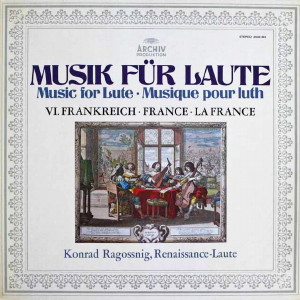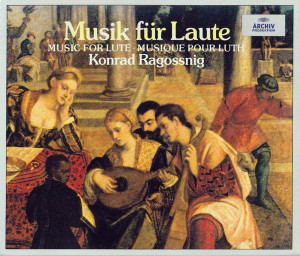 |
|
1 LP -
2533 304 - (p) 1976
|
 |
| 4 CD's -
447 727-2 - (c) 1995 |
|
| MUSIK FÜR LAUTE |
|
|
|
|
|
|
|
| Lute Music of the Renaissance
- VI. Frankreich · France · La France |
|
|
|
|
|
|
|
| Pierre Attaingnant
(ca.1494-1552 |
Tant que vivray
(Chanson) |
Tres breve et
familiere introduction, Paris
1529. NA: H.D. Bruger,
Solostücke für die Laute,
Möseler Verlag, Wolfenbüttel
1926 |
|
2' 09" |
A1 |
|
Basse dance
"Sansserre" |
Dix-huit basses
dances, Paris 1529. NA: H.
Mönkemeyer, Die Tabulatur, Heft
4, Verlag F. Hofmeister, Hofheim
am Taunus1966 |
|
1' 00" |
A2 |
|
Branle gay
"C'est mon amy" |
Dix-huit basses
dances, Paris 1529. NA: H.
Mönkemeyer, Die Tabulatur, Heft
4, Verlag F. Hofmeister, Hofheim
am Taunus1966 |
|
1' 24" |
A3 |
|
Basse dance "la
Magdalena" |
Dix-huit basses
dances, Paris 1529. NA: H.
Mönkemeyer, Die Tabulatur, Heft
4, Verlag F. Hofmeister, Hofheim
am Taunus1966 |
|
2' 53" |
A4 |
|
Destre amoureux
"Chanson) |
Tres breve et
familiere introduction, Paris
1529. NA: H.D. Bruger,
Solostücke für die Laute,
Möseler Verlag, Wolfenbüttel
1926 |
|
1' 40" |
A5 |
|
Haulberroys |
Dix-huit basses
dances, Paris 1529. NA: H.
Mönkemeyer, Die Tabulatur, Heft
4, Verlag F. Hofmeister, Hofheim
am Taunus1966 |
|
1' 05" |
A6 |
| Adrien
Le Roy (ca.1520-1598) |
Passemeze |
A briefe
and easye Introduction,
London 1568. NA: P.
Jansen, Centre National
de la Recherche
Scientifique (C.N.R.S.),
Paris 1962 |
|
1' 15" |
A7 |
| Robert
Ballard (ca.1575 - nach 1650)
|
Entrée de Luth
I-II-III |
Premier Livre de
Luth, Paris 1611. NA:
A.Souris/S.Spycket, C.N.R.S.,
Paris 1964 |
|
4' 53" |
A8 |
|
Courante |
Premier Livre de
Luth, Paris 1611. NA:
A.Souris/S.Spycket, C.N.R.S.,
Paris 1964 |
|
1' 48" |
A9 |
|
Branles de
village |
Diverses Pieces
mises sur le luth, Paris 1614.
NA: A.Souris/S.Spycket,
C.N.R.S., Paris 1964 |
|
2' 58" |
A10 |
| Jean-Baptiste
Besard (ca.1567 - ca.1625) |
Branle |
Thesaurus
harmonicus, Kölm 1603.
NA: M.Seiber/J.Bream,
Eight dances from
Thesaurus harmonicus,
Schott, London 1956 |
|
1' 02" |
B1 |
|
Gagliarda |
Thesaurus
harmonicus, Kölm 1603.
NA: M.Seiber/J.Bream,
Eight dances from
Thesaurus harmonicus,
Schott, London 1956 |
|
1' 26" |
B2 |
|
Branle gay |
Thesaurus
harmonicus, Kölm 1603.
NA: M.Seiber/J.Bream,
Eight dances from
Thesaurus harmonicus,
Schott, London 1956 |
|
1' 00" |
B3 |
|
Gagliarda vulgo
dolorata |
Thesaurus harmonicus, Kölm 1603. NA: M.Seiber/J.Bream,
Eight dances
from Thesaurus
harmonicus,
Schott, London
1956
|
|
2' 03" |
B4 |
|
Allemande |
Thesaurus
harmonicus, Kölm 1603.
NA: M.Seiber/J.Bream,
Eight dances from
Thesaurus harmonicus,
Schott, London 1956 |
|
1' 20" |
B5 |
|
Air de cour
"J'ai trouvé sur l'herbe assise" |
Thesaurus
harmonicus, Kölm 1603.
NA: M.Seiber/J.Bream,
Eight dances from
Thesaurus harmonicus,
Schott, London 1956 |
|
1' 39" |
B6 |
|
Volte |
Thesaurus
harmonicus, Kölm 1603.
NA: M.Seiber/J.Bream,
Eight dances from
Thesaurus harmonicus,
Schott, London 1956 |
|
1' 03" |
B7 |
|
Branle - Branle
gay |
Thesaurus
harmonicus, Kölm 1603.
NA: O. Chilesotti,
Lautenspieler des 16.
Jh., Breitkopf &
Härtel, Leipzig 1891 |
|
1' 45" |
B8 |
|
Guillemette |
Thesaurus
harmonicus, Kölm 1603.
Übertragung: K.
Ragossnig |
|
1' 25" |
B9 |
|
Ballet |
Novus
Partus, Augsburg 1617.
NA: O. Chilesotti, Lautenspieler des 16. Jh., Breitkopf
& Härtel,
Leipzig 1891 |
|
1' 00" |
B10 |
|
Pass' e mezo |
Thesaurus
harmonicus, Kölm 1603. NA: O.
Chilesotti, Lautenspieler des 16. Jh.,
Breitkopf & Härtel, Leipzig 1891
|
|
2' 47" |
B11 |
|
Chorea rustica |
Thesaurus
harmonicus, Kölm 1603.
NA: M.Seiber/J.Bream,
Eight dances from
Thesaurus harmonicus,
Schott, London 1956 |
|
0' 40" |
B12 |
|
|
|
|
Konrad RAGOSSNIG,
Laute
|
| Achtchörige
Renaissance-Laute von David J. Rubio, Duns
Tew/Oxford, 1971 (Kopie nach Martin
Hoffmann, Leipzig, 2.Hälfte des 17.
Jahrhunderts) |
|
|
|
|
Luogo
e data di registrazione |
|
Alter
Herkules-Saal, Residenz, München
(Germania) - 28/29 giugno 1975 |
|
|
Registrazione:
live / studio |
|
studio |
|
|
Executive Producer |
|
Dr.
Andreas Holschneider |
|
|
Recording Producer |
|
Heinz
Wildhagen |
|
|
Balance Engineer |
|
Heinz
Wildhagen |
|
|
Prima Edizione LP |
|
ARCHIV
- 2533 304 - (1 LP - durata 38'
05") - (p) 1976 - Analogico |
|
|
Prima Edizione CD |
|
ARCHIV
- 447 727-2 - (4 CD's - durata 71'
05"; 73' 47"; 68' 14" & 62'
37" - [CD4 12-33]) - (c) 1995 -
ADD
|
|
|
Cover |
|
Alabraham
Bosse (1602-1676) "Musikalische
Gesellschaft", Bibliothèque
Nationale, Paris - Photo
Westermann, Braunschweig
|
|
|
Note |
|
-
|
|
|
|
|
Pierre
Attaingnant, printer, publisher
and music-seller in Paris,
published a tutor for the lute
in 1529 (Tres breve er
familiere introduction pour
entendre et apprendre ... lutz)
and followed this in the same
year with a new volume of dances
for the lute (18 basses
dances garnies de recoupes ...
lutz). Both publications
reflect the musical taste and
the performance practices of his
period. The arrangers (or
composers) remain anonymous.
Both collections consist mainly
of dances in two or three parts,
three-part transcriptions of
chansons, and chansons for voice
and lute accompaniment. The
chanson versions are transcribed
in three parts, with the melody
always in the highest part. In
the desire for a clear melodic
line, contrapuntal textures are
avoided, and only cadential
points are decorated with
passage-work as well as the
breaks between two sections. The
transcriptions of dances in
Attaingnant’s publications
emphasize the top voice. Often
the accompaniment consists of
open bass strings. In addition
to round-dances in a single
section, like Haulberroys,
Branle and Pavane, there are
interesting three-part Basse
danses (court dances). The
melodic material of the quiet Basse
danse in square time
reappears in a Recoupe or Retour
in triple or compound metre and
quicker tempo. This is followed
by a Tourdion (turning dance) in
very quick tempo also in triple
or compound metre and using new
melodic material.
During the second half of the
16th century and a large part of
the 17th, the publishing house
of Adrien Le Roy and Robert
Ballard assumed the same
importance as that of
Attaingnant in the earlier
period. Le Roy was an
outstanding lutenist. His
didactic works were a lasting
influence on subsequent
developments. The Passamezzo is
a very stylized dance, usually
consisting of several sections
based on a given and unchanged
basso ostinato (ground). The
“Passemeze” on this recording is
based on the “Passamezzo
antico”.
Such a “ground” forms also the
scaffolding for “Entrée III” by
Robert Ballard. “Entrées de
Luth” are interludes in the
French Ballets de cour
and vary in character and
texture in accordance with the
scene they precede. Robert
Ballard was lutenist to Queen
Maria de’ Medici. His style of
lute composition consists of an
interplay of full chords and
mock-polyphonic arpeggios and
anticipates the lute technique
of the 17th and 18th centuries.
In the four “Branles de
village”, a sequence of two-part
dances, the drone-accompaniment
of tonic and fifth is meant to
symbolize “rusticity” (ef Chorea
rustica by Besard).
Jean-Baptiste Besard was one of
the most versatile French
lutenists. He was a doctor of
law, a physician and a lute
pupil of Lorenzini in Rome. In
1604 he published a literary
work in Cologne and, after many
cultural tours, settled in 1617
in Augsburg where he published
two further collections of lute
music, source works on the lute
techniques of his time Besard
favours a full, chordal texture
and in his notes to the players
he includes specific stretching
exercises for the left hand. He
cultivates the entire compass of
the lute and he employs extreme
registers. He includes pieces by
lutenists with similar aims,
like P. Bononiensis in his Gagliarda
vulgo dolorata.
Besard spread the “airs de cour”
to a wider area by being the
first to include them in a book
of tablatures in Germany. He
interestingly incorporated the
separate vocal line in some of
his examples in the lute part,
as in the air de cour “J’ai
trouvé sur l’herbe assise”.
|
|
|

